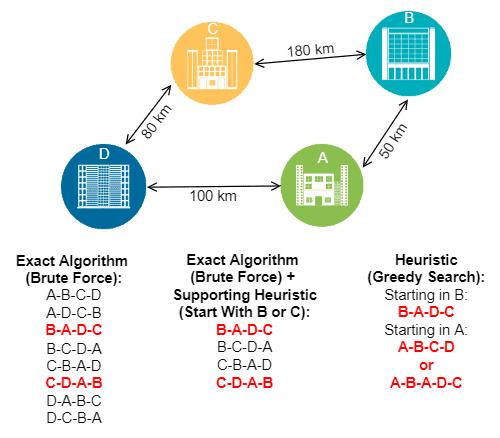1. 引言
本文将介绍 Heuristics(启发式算法)、Metaheuristics(元启发式算法)以及 Probabilistic Algorithms(概率算法)三者之间的区别与联系,并通过具体示例帮助理解它们在算法设计中的角色和应用场景。
我们会从计算机问题求解和优化问题谈起,然后深入探讨每种策略的定义、特点和实际应用,最后通过对比总结帮助你更好地选择适合的算法策略。
2. 计算机中的问题求解
计算机科学的核心之一就是解决问题,尤其是优化问题。
比如,我们可以用图论和算法来计算两点之间的最短路径,或者根据物品的体积和重量决定如何最优地装包。这些问题分别对应经典的“旅行商问题(TSP)”和“背包问题(Knapsack Problem)”。
解决这些问题的策略多种多样:
- 有些策略能保证找到最优解;
- 有些策略则通过牺牲最优性来换取执行效率;
- 有的策略只能解决特定问题,有的则具有通用性。
我们可以将这些策略分为 精确算法(Exact Algorithms) 和 非精确算法(Non-exact Algorithms)。
2.1 精确与非精确策略
- 精确算法:能保证找到最优解,比如暴力搜索(Brute-force)。
- 非精确算法:不能保证最优解,但能在合理时间内找到“足够好”的解。
✅ Heuristics、Metaheuristics、Probabilistic Algorithms 都属于非精确策略。
比如贪心算法、禁忌搜索、遗传算法等都属于这一类。
3. 启发式算法(Heuristics)
启发式算法是基于问题本身特性设计的一种策略,用于快速找到有希望的解。
它的目标不一定是找到最优解,而是找到一个“足够好”的解。例如贪心搜索(Greedy Search)就是典型的启发式算法。
有时启发式算法也用于排除明显不合理的解,从而缩小搜索空间,这类启发式称为辅助启发式(Supporting Heuristics)。
特点
- ✅ 问题导向设计:一个启发式通常只能解决特定问题(One-to-One)
- ❌ 不可量化成功概率:无法明确知道当前解距离最优解有多远
- ⚠️ 执行效率高:比精确算法快,资源消耗低
示例图解
下图展示了精确算法、辅助启发式和贪心启发式在旅行商问题中的表现:

- 红色结果为最终输出
- 精确算法始终返回全局最优
- 启发式可能返回最优,也可能不,取决于参数设定
4. 元启发式算法(Metaheuristics)
与启发式不同,元启发式是一种通用策略,可以应用于多种问题。
它同样不保证最优解,但具有更强的适应性。通过调整输入参数,同一个元启发式算法可以用于解决不同问题。
特点
- ✅ 通用设计:适用于多种问题(Problem-independent)
- ❌ 不可量化成功概率
- ⚠️ 执行效率高
常见类型
- 局部搜索(Local Search):通过逐步改进一个解来寻找更优解
- 构造式(Constructive):将问题拆解为子问题,分别求解后合并
- 群体智能(Population-based):维护一组候选解,通过交叉、变异等操作优化
示例图解
下图展示了使用遗传算法(一种群体智能类元启发式)解决旅行商问题的过程:

- 每一代解都通过随机操作(如交叉、变异)进化
- 最终解可能不是最优,但通常足够好
5. 概率算法(Probabilistic Algorithms)
概率算法是一类使用随机性来提高效率的非精确策略。
与启发式和元启发式不同的是,它的目标是找到最优解,只是通过引入随机性来提升效率。
但它 不保证一定能找到最优解,也不保证执行时间一定短。
主要类型
| 类型 | 特点 |
|---|---|
| Monte Carlo | 快速得出结果,但结果可能不正确或不最优 |
| Las Vegas | 总能找到正确或最优解,但运行时间不固定 |
| Sherwood | 总能找到正确或最优解,随机性避免最坏情况,执行时间较稳定 |
示例:Monte Carlo 算法
以下是一个判断列表中是否存在“多数元素”(出现次数超过一半)的 Monte Carlo 算法伪代码:
algorithm MonteCarloMajority(numberList, lengthList):
// INPUT
// numberList = a list of numbers
// lengthList = the length of numberList
// OUTPUT
// Returns true if a randomly selected number appears more than lengthList / 2 times,
// and false otherwise
i <- RANDOM() mod lengthList
// RANDOM() returns a random number
j <- 0
c <- 0
while j < lengthList:
if numberList[i] = numberList[j]:
c <- c + 1
j <- j + 1 return c > lengthList / 2
- 如果存在多数元素,错误返回的概率 < 1/2
- 多次运行后,错误概率降至 (1/2)^N
⚠️ 虽然错误概率趋近于零,但永远不能完全排除错误的可能性。
6. 对比总结
下表对比了四类算法的核心特性:
| 特性 | 精确算法 | 启发式 | 元启发式 | 概率算法 |
|---|---|---|---|---|
| 是否保证最优解 | ✅ 是 | ❌ 否 | ❌ 否 | ❌ 否 |
| 是否保证正确解 | ✅ 是 | ✅ 是 | ✅ 是 | ❌ 否 |
| 执行时间 | 通常较长 | 通常较快 | 可调,通常较快 | 通常较快 |
| 应用场景 | 需最优解的问题 | 特定问题 | 多种问题 | 需概率优化 |
7. 总结
在面对复杂问题时,精确算法往往不现实。此时,启发式、元启发式和概率算法成为我们解决问题的重要工具。
- ✅ 启发式:适合特定问题,设计简单,效率高
- ✅ 元启发式:通用性强,可应用于多种问题,但需调参
- ✅ 概率算法:引入随机性,提升效率,但结果有不确定性
在实际开发中,选择哪种策略取决于问题规模、对结果质量的要求以及可用的计算资源。掌握这些策略的适用场景,是每个高级程序员必备的技能。